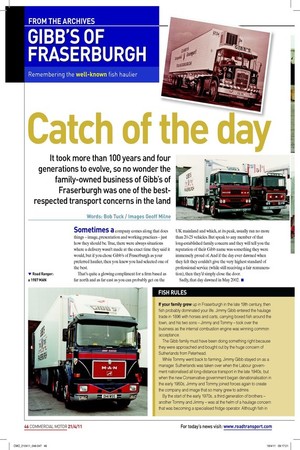FISH RULES
Page 38

Page 39

If you've noticed an error in this article please click here to report it so we can fix it.
If your family grew up in Fraserburgh in the late 19th century, then fish probably dominated your life. Jimmy Gibb entered the haulage trade in 1896 with horses and carts, carrying boxed fish around the town, and his two sons – Jimmy and Tommy – took over the business as the internal combustion engine was winning common acceptance.
The Gibb family must have been doing something right because they were approached and bought out by the huge concern of Sutherlands from Peterhead.
While Tommy went back to farming, Jimmy Gibb stayed on as a manager. Sutherlands was taken over when the Labour government nationalised all long-distance transport in the late 1940s, but when the new Conservative government began denationalisation in the early 1950s, Jimmy and Tommy joined forces again to create the company and image that so many grew to admire.
By the start of the early 1970s, a third generation of brothers – another Tommy and Jimmy – was at the helm of a haulage concern that was becoming a specialised fridge operator. Although fish in open boxes – filled out with ice – had been a traditional traffic, the requirement to load these directly into a fridge vehicle had seen Gibb’s build its own demountable fridge containers. Chaining these onto the back of its eight-wheel flats gave the firm the option of being able to take the box off if it wanted to do anything else.
However, Gibb’s made such a good job of this new mode of haulage that the demounts were phased out and fridge van trailers – often built by Gray & Adams from Fraserburgh – came into regular use.
A clockwork service with well turned-out drivers and pristine vehicles was what Gibb’s was all about. But what the company couldn’t live with were the factors outside its control. As the EC dictated a dwindling fish quota for the UK, that work declined and when the BSE crisis decimated the reputation of the British beef industry, specialised hauliers such as Gibb’s were severely hit.
Problems were compounded by Continental vehicles coming into Fraserburgh and picking up traffic long done by Gibb’s, simply because lower overheads allowed them to cut the rates. You can’t fight that and you can’t fight the operator who will drive night and day to deliver a load where Gibb’s might use three different drivers just to stay legal.
In the late 1990s, it was fourth-generation James Gibb who wrestled with trying to keep things afloat. Having out-based drivers and going further afield to collect a bigger variety of freight were two of the options tried by Gibb’s, but without great success.
The only other option was to bow out of the business while it could still hold its head high. Rather than go into liquidation leaving a trail of debts, Gibb’s decided to close the doors and finalise its affairs in the proper manner. Two sales were organised – the trucks were sold in England to maximise their value, while the fixtures and fittings of the Fraserburgh HQ went to the highest bidder.
With Gray & Adams absorbing the old Gibb’s yard into its huge reefer building factory, the only place you’ll find any strong reference to Gibb’s in town is at the Fraserburgh Heritage Centre. However, one thing no one can take away is the memory the family firm carved out for itself – it was simply one of the best.













































